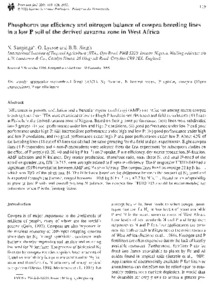| dc.contributor.author | Sanginga, N. |
| dc.contributor.author | Lyasse, O. |
| dc.contributor.author | Singh, B. |
| dc.date.accessioned | 2019-12-04T11:21:07Z |
| dc.date.available | 2019-12-04T11:21:07Z |
| dc.date.issued | 2000 |
| dc.identifier.citation | Sanginga, N., Lyasse, O. & Singh, B. (2000). Phosphorus use efficiency and nitrogen balance of cowpea breeding lines in a low P soil of the derived savanna zone in West Africa. Plant and Soil, 220, 119-128. |
| dc.identifier.issn | 0032-079X |
| dc.identifier.uri | https://hdl.handle.net/20.500.12478/3676 |
| dc.description.abstract | Differences in growth, nodulation and arbuscular mycorrhizal fungi (AMF) root infection among recent cowpea breeding lines from IITA were examined at low and high P levels in pot (94 lines) and field experiments (43 lines) at Fashola in the derived savanna zone of Nigeria. Based on their growth performance, these lines were subdivided into 5 groups: (i) poor performance under low and high P conditions; (ii) good performance under low P and poor performance under high P; (iii) intermediate performance under high and low P; (iv) good performance under high and low P conditions; and (v) good performance under high P and poor performance under low P. About 42% of the breeding lines (18 out of 43 lines tested) had the same grouping for the field and pot experiments. Eight cowpea lines (4 P-responders and 4 non-P-responders) were selected from the first experiment for subsequent studies on the effect of P supply (0, 20, 40 and 60 kg P ha-1) on P uptake, P use efficiency, dry matter production, N-fixation, AMF infection and N balance. Dry matter production, shoot/root ratio, total shoot N, and total N-fixed of the non-P-responder line, IT81D-715, were strongly related to P uptake efficiency. The P-responder IT81D-849 had a significant (95%) correlation between AMF and P-use efficiency. The cowpea lines fixed on average 22 kg N ha-1, which was 70% of the plant total N. The N balance based on the difference between the amount of N2 fixed and N exported through the harvest, ranged between −10.6 kg N ha-1 and +7.7 kg N ha-1. Based on its adaptability to grow in low P soils and overall positive N balance, the cowpea line IT81D-715 should be recommended for cultivation when P is the limiting factor. |
| dc.language.iso | en |
| dc.subject | Arbuscular Mycorrhizal Fungi |
| dc.subject | N2 Fixation |
| dc.subject | N Harvest Index |
| dc.subject | P Uptake |
| dc.subject | Cowpeas |
| dc.subject | P Use Efficiency |
| dc.subject | Soil Fertility |
| dc.subject | Soil Nutrient |
| dc.title | Phosphorus use efficiency and nitrogen balance of cowpea breeding lines in a low P soil of the derived savanna zone in West Africa |
| dc.type | Journal Article |
| dc.description.version | Peer Review |
| cg.contributor.affiliation | International Institute of Tropical Agriculture |
| cg.coverage.region | Africa |
| cg.coverage.region | West Africa |
| cg.coverage.country | Nigeria |
| cg.isijournal | ISI Journal |
| cg.authorship.types | CGIAR single centre |
| cg.iitasubject | Plant Production |
| cg.iitasubject | Farm Management |
| cg.iitasubject | Plant Breeding |
| cg.iitasubject | Nutrition |
| cg.iitasubject | Integrated Soil Fertility Management |
| cg.iitasubject | Smallholder Farmers |
| cg.iitasubject | Handling, Transport, Storage And Protection Of Agricultural Products |
| cg.iitasubject | Soil Fertility |
| cg.iitasubject | Soil Health |
| cg.accessibilitystatus | Limited Access |
| local.dspaceid | 95831 |

